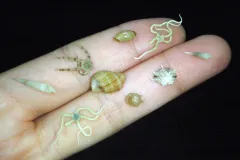On Biodiversity: Understanding its Meaning and Importance

The ocean is home to a phenomenal diversity of marine organisms. They have evolved to inhabit warm waters near the equator and the icy waters of the Earth’s poles. Marine life takes advantage of the enormous volume the ocean comprises: from diatoms living near the sunny surface, to octopods living in the dark deep sea. From humpback whales that travel thousands of miles in the open ocean to sessile corals rooted to one spot, marine life spans a fantastic variety of forms and plays a multitude of different ecological roles in Earth’s global ocean system.
The nine animals on the fingertips in this photo were found near Curaçao in the southern Caribbean, and represent a teeny-tiny fraction of life in the ocean. These gastropods and echinoderms were collected with a submersible below 60m (~200 ft) while Smithsonian scientists were searching for deep-sea crustaceans.
The photo makes me think about the diversity of life and whole communities not easily visible in the ocean and on land. Smithsonian researchers are attempting to document and monitor the biodiversity of coral reefs off Curaçao and hope to expand this deep-sea research to other parts of the Caribbean.
For some, the word "biodiversity" calls to mind tropical rainforests and coral reefs, while others think of the incredible variety of beetles or endangered species. Whatever the context, the word very successfully helps focus attention on the living components of the Earth’s diversity.
Biodiversity is a complex concept, and it is helpful to think about it at different levels—ecosystems, species, and genes, to name a few. Ecologists, taxonomists, geneticists, and other biologists study biodiversity in different ways. Their collective work helps us better understand how species interact with one another and their environment, how they are classified, and how they evolve. These scientific findings show the value of protecting habitats, individual species, and the genetic diversity that gives rise to variation.
It is truly incredible to think about the species that have not yet been discovered. The Census of Marine Life estimates that there are at least one million species of plants and animals in the sea; most of which have not been described. When you consider that many of the known vertebrates are threatened with extinction, the call to understand the planet's variety of life becomes even more urgent.
Editor's Note: This is the sixth and final post in our "Summer in a Sub" blog series, which features the work of the Smithsonian's Deep Reef Observation Project (DROP).

